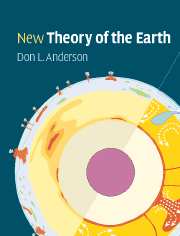ReferencesAnderson, D. L. (2005) Scoring hotspots: the plume and plate paradigms, in Plates, Plumes, and Paradigms, pp. 31–54, ed. Foulger, G. R., Natland, J. H., Presnall, D. C., and Anderson, D. L., Boulder, C. O., Geological Society of America Special Paper 388.
Baig, A. M. and Dahlen, F. A. (2004) Travel time biases in random media and the S-wave discrepancy. Geophys. J. Inter., 158, 922–38.
Becker, T. W. and Boschi, L. (2002) A comparison of tomographic and geodynamic mantle models. Geochem. Geophys. Geosyst., 3, 2001GC000168.
Bijwaard, H., Spakman, W. and Engdahl, E. (1998) Closing the gap between regional and global travel time tomography. J. Geophys. Res. 103, 30055–78.
Dziewonski, A. M. (2005) The robust aspects of global seismic tomography. In Plates, Plumes and Paradigms, eds. Foulger, G. R., Natland, J. H., Presnall, D. C. and Anderson, D. L.Boulder, CO, Geological Society of America, pp. 147–54.
Forsyth, D. and Uyeda, S. (1975) On the relative importance of the driving forces of plate motion. Geophys. J. R. Astr. Soc., 43, 163–200.
Foulger, G. L., Natland, J. H., Presnall, D. C. and Anderson, D. L., eds. (2005) Plates, Plumes and Paradigms. Boulder, CO, Geological Society of America, Special Paper 388.
Grand, S. P. (1986) Shear velocity structure of the mantle beneath the North American plate, Ph.D. Thesis, California Institute of Technology.
Grand, S. P. (1994) Mantle shear structure beneath the Americas and surrounding oceans. J. Geophys. Res., 99, 591–621.
Grand, S. P. and Helmberger, D. (1984a) Upper mantle shear structure of North America. Geophys. J. Roy. Astron. Soc., 76, 399–438.
Grand, S. P. and Helmberger, D. (1984b) Upper mantle shear structure beneath the Northwest Atlantic Ocean. J. Geophys. Res., 89, 11, 465–75.
Grand, S. P., van der Hilst, R. and Widiyantoro, S. (1997) Global seismic tomography: a snapshot of convection in the Earth. GSA Today, 7, 1–7.
Gu, Y. J., Dziewonski, A. and Ekström, G. (2001) Preferential detection of the Lehmann discontinuity beneath continents. Geophys. Res. Lett., 28, 4655–8.
Hager, B. H. (1983) Global isostatic geoid anomalies for plate and boundary layer models of the lithosphere. Earth Planet. Sci. Lett., 63, 97–109.
Hager, B. H. and Clayton, R. W. (1986) Constraints on the structure of mantle convection using seismic observations, flow models and the geoid. In Mantle Convection, ed. Peltier, W. R.New York, Gordon and Breach Science Publishers, pp. 657–763.
Ishii, M. and Tromp, J. (2004) Constraining large-scale mantle heterogeneity using mantle and inner-core sensitive normal modes. Physics of the Earth and Planetary Interiors, 146, 113–24.
Nakanishi, I. and Anderson, D. L. (1983) Measurements of mantle wave velocities and inversion for lateral heterogeneity and anisotropy: Part I, Analysis of great circle phase velocities. J. Geophys. Res., 88, 10267–83.
Nakanishi, I. and Anderson, D. L. (1984a) Aspherical heterogeneity of the mantle from phase velocities of mantle waves. Nature, 307, 117–21.
Nakanishi, I. and Anderson, D. L. (1984b). Measurements of mantle wave velocities and inversion for lateral heterogeneity and anisotropy: Part II, Analysis by single-station method. Geophys. J. Roy. Astron. Soc., 78, 573–617.
Polet, J. and Anderson, D. L. (1995) Depth extent of cratons as inferred from tomographic studies. Geology, 23, 205–8.
Ray, T. W. and Anderson, D. L. (1994) Spherical disharmonics in the Earth sciences and the spatial solution; ridges; ridges, hotspots, slabs, geochemistry and tomography correlations. J. Geophys. Res., 99, 9605–14.
Scrivner, C. and Anderson, D. L. (1992) The effect of post Pangea subduction on global mantle tomography and convection. Geophys. Res. Lett., 19, 1053–6.
Shearer, P. M. and Earle, P. S. (2004) The global short-period wavefield modelled with a Monte Carlo seismic phonon method. Geophys. J. Int., 158, 1103–17.
Shapiro, N. M. and Ritzwoller, M. H. (2004) Thermodynamic constraints on seismic inversions. Geophys. J. Int. 157, 1175–88, doi:10.1111/j.1365–246X.2004.02254.x, 2004.
Spakman, W. and Nolet, G. (1988) Imaging algorithms, accuracy and resolution in delay time tomography. In Mathematical Geophysics, eds. Reidel.
Spakman, W., Stein, S., Hilst, R. and Wortel., R. (1989). Resolution experiments for NW Pacific Subduction Zone Tomography. Geophys. Res. Lett., 16, 1097–100.
Su, W.-J. and Dziewonski, A. M. (1991) Predominance of long-wavelength heterogeneity in the mantle. Nature, 352, 121–6.
Su, W.-J. and Dziewonski, A. M. (1992) On the scale of mantle heterogeneity. Phys. Earth Planet. Inter. 74, 29–54.
Tanimoto, T. (1991) Predominance of large-scale heterogeneity and the shift of velocity anomalies between the upper and lower mantle. J. Phys. Earth, 38, 493–509.
Tanimoto, T. and Anderson, D. L. (1984) Mapping convection in the mantle. Geopkys. Res. Lett., 11, 287–90.
Tanimoto, T. and Anderson, D. L. (1985) Lateral heterogeneity and azimuthal anisotropy of the upper mantle: Love and Rayleigh waves 100–250 sec. J. Geophys. Res., 90, 1842–58.
Thoraval, C., Machetel, Ph. and Cazanave, A. (1995) Locally layered convection inferred from dynamic models of the Earth's mantle. Nature, 375, 777–80.
Trampert, J., Deschamps, F., Resovsky, J. and Yuen, D. (2004) Probabilistic tomography maps chemical heterogeneities throughout the lower mantle. Science, 306, 853–6.
Vasco, D. W., Johnson, L. R. and Pulliam, J. (1995) Lateral variations in mantle velocity structure and discontinuities determined from P, PP, S, SS, and SS-S_pS travel time residuals. J. Geophys. Res., 100, 24037–59.
Walck, M. C. (1984) The P-wave upper mantle structure beneath an. active spreading center: The Gulf of California. Geophys. J. R. Astron. Soc., 76, 697–723.
Wen, L. and Anderson, D. L. (1995) The fate of slabs inferred from seismic tomography and 130 million years of subduction. Earth Planet. Sci. Lett., 133, 185–98.
Wen, L. and Anderson, D. L. (1997) Slabs, hotspots, cratons and mantle convection revealed from residual seismic tomography in the upper mantle. Phys. Earth Planet. Inter., 99, 131–43.
Whitcomb, J. H. and Anderson, D. L. (1970) Reflection of P′P′ seismic waves from discontinuities in the mantle. J. Geophys. Res., 75, 5713–28.





